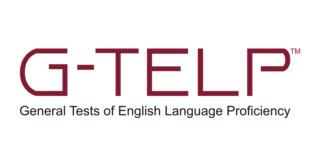
Test of English as a Foreign Language is a standardized test to measure the English language ability of non-native speakers wishing to enroll in English-speaking universities. The test is accepted by more than 11,000 universities and other institutions in over 190 countries and territories. TOEFL is one of several major English-language tests worldwide, including IELTS, Duolingo English Test, Cambridge Assessment English, and Trinity College London exams.

International English Language Testing System is an international standardized test of English language proficiency for non-native English language speakers. It is jointly managed by the British Council, IDP and Cambridge English, and was established in 1989. IELTS is one of the major English-language tests in the world. The IELTS test has two modules: Academic and General Training. IELTS One Skill Retake was introduced for computer-delivered tests in 2023, which allows a test taker to retake any one section of the test.
The College English Test, better known as CET, is a national English as a foreign language test in the People's Republic of China. It examines the English proficiency of undergraduate and postgraduate students in China. It is meant to ensure that Chinese undergraduates and postgraduates reach the required English levels specified in the National College English Teaching Syllabuses (NCETS). This test has existed in China for 26 years and now 18 million people take it annually. It includes two levels, CET4 (四级) and CET6 (六级), and prefers American English.

Pilot certification in the United States is typically required for an individual to act as a pilot-in-command of an aircraft. It is regulated by the Federal Aviation Administration (FAA), a branch of the U.S. Department of Transportation (USDOT). A pilot may be certified under 14 Code of Federal Regulations (CFR) Part 61 or 14 CFR Part 141. Pilots may also be certified under 14 CFR Part 107 for commercial drone operations.
Advanced Placement (AP) Spanish Language and Culture is a course and examination offered by the College Board in the United States education system as part of the Advanced Placement Program.
The Versant suite of tests are computerized tests of spoken language available from Pearson PLC. Versant tests were the first fully automated tests of spoken language to use advanced speech processing technology to assess the spoken language skills of non-native speakers. The Versant language suite includes tests of English, Spanish, Dutch, French, and Arabic. Versant technology has also been applied to the assessment of Aviation English, children's oral reading assessment, and adult literacy assessment.
Advanced Placement (AP) French Language and Culture is a course offered by the College Board to high school students in the United States as an opportunity to earn placement credit for a college-level French course. The AP French Language test is widely compared to a final examination for a French 301 college course. Enrollment requirements for AP French Language differ from school to school, but students wishing to enter it should have a good command of French grammar and vocabulary as well as prior experience in listening, reading, speaking, and writing French and a holistic cultural knowledge of francophone regions. The AP French Language and Culture exam underwent a change beginning in May 2012 designed to better test interpretive, interpersonal, and presentational communication skills.
The Test of English Proficiency developed by Seoul National University or TEPS is an English proficiency test created by Seoul National University's Language Education Institute to evaluate South Korean test takers' English language skills. TEPS has been administered nationwide since January 1999. It consists of 200 questions which are divided into four sections: Listening, Grammar, Vocabulary, and Reading. TEPS scores are divided into the ten ratings ranging from 1 + to 5. It is designed to test applicants' communicative English skills and to minimize test-taker reliance on certain strategies such as rote memorization. A study of the test indicated that it is valid and fair.
C2 Proficiency, previously known as Cambridge English: Proficiency and the Certificate of Proficiency in English (CPE), is an English language examination provided by Cambridge Assessment English (previously known as Cambridge English Language Assessment and University of Cambridge ESOL examination).
The Psychometric Entrance Test (PET) – commonly known in Hebrew as "ha-Psikhometri" – is a standardized test that serves as an entrance exam for institutions of higher education in Israel. The PET covers three areas: quantitative reasoning, verbal reasoning and English language. It is administered by the National Institute for Testing and Evaluation (NITE) and plays a considerable role in the admissions process. A score combining students' performance on the PET with the average score of their high school matriculation tests has been found to be a highly predictive indicator of students' academic performance in their first year of higher education.
Language assessment or language testing is a field of study under the umbrella of applied linguistics. Its main focus is the assessment of first, second or other language in the school, college, or university context; assessment of language use in the workplace; and assessment of language in the immigration, citizenship, and asylum contexts. The assessment may include listening, speaking, reading, writing, an integration of two or more of these skills, or other constructs of language ability. Equal weight may be placed on knowledge and proficiency, or greater weight may be given to one aspect or the other.

Aviation communication refers to the conversing of two or more aircraft. Aircraft are constructed in such a way that make it very difficult to see beyond what is directly in front of them. As safety is a primary focus in aviation, communication methods such as wireless radio are an effective way for aircraft to communicate with the necessary personnel. Aviation is an international industry and as a result involves multiple languages. The International Civil Aviation Organization (ICAO) deemed English the official language of aviation. The industry considers that some pilots may not be fluent English speakers and as a result pilots are obligated to participate in an English proficiency test.
The Test of English for Aviation (T.E.A.) is a language proficiency test designed and developed by Mayflower College in the United Kingdom.
TOEFA is the acronym for the Test of English for Aviation, that was the first worldwide examination presented by its author William Aranda, PhD, from Peru, at the International Aviation Language Symposium (IALS) organized by the International Civil Aviation Organization ICAO) in Montreal, Canada, in September 2004. It was validated with air traffic controllers from Nicaragua, Panama, Bolivia and Peru and with pilots of Peru and Greece.
Aviation English is the de facto international language of civil aviation. With the expansion of air travel in the 20th century, there were safety concerns about the ability of pilots and air traffic controllers to communicate. In 1951, the International Civil Aviation Organization (ICAO) recommended in "ICAO Annex 10 ICAO to the International Chicago Convention" that English be universally used for "international aeronautical radiotelephony communications." Despite being a recommendation only, ICAO aviation English was widely accepted.

SAT Subject Tests were a set of multiple-choice standardized tests given by The College Board on individual topics, typically taken to improve a student's credentials for college admissions in the United States. For most of their existence, from their introduction in 1937 until 1994, the SAT Subject Tests were known as Achievement Tests, and until January 2005, they were known as SAT II: Subject Tests. They are still commonly known by these names. Unlike the Scholastic Aptitude Test (SAT) that the College Board offers, which are intended to measure general aptitude for academic studies, the Achievement Tests are intended to measure the level of knowledge and understanding in a variety of specific subjects. Like the SAT, the scores for an Achievement Test range from 200 (lowest) to 800 (highest).
English Language Proficiency for Aeronautical Communication Test (ELPAC) is a EUROCONTROL test for aeronautical communication designed to assess ICAO English Language Proficiency for pilots and air traffic controllers, and reflects the range of tasks undertaken in air traffic control and pilot communications. The test focuses on language proficiency, not operational procedures.
Advanced Placement (AP) International English Language is an AP Examinations course managed by Educational Testing Service (ETS) with the sponsorship of the College Board in New York. It is designed for non-native speakers to prepare for studying in an English-speaking university, particularly in North America. The course also gives students a chance to earn college credit. The three-hour exam assesses four language skills: listening, reading, writing, and speaking. The test paper has two sections: multiple-choice questions and free-response questions. APIEL committee consists of high school and university English teachers from Belgium, China, France, Germany, Switzerland, and the United States.

General Tests of English Language Proficiency (G-TELP) are English language tests, developed by the International Testing Services Center (ITSC) in 1985. They comprehensively evaluate the practical English use ability of test takers who do not speak English as their native language.





